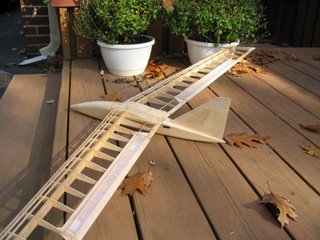 A close-up of the servo installation in the Genesis. Two spruce cross pieces are glued into the fuselage, and the servos are held in with screws.
A close-up of the servo installation in the Genesis. Two spruce cross pieces are glued into the fuselage, and the servos are held in with screws.I originally tried mounting the servos in the wing, but I could not get the controls to operate properly with the elevon mixing feature on the transmitter.
I had to replace the "X" shaped servo arms with the long arms (with one arm cut off) in order to get enough travel on the elevons. These arms come with the servos, and are also available as a spare part.
The control rods and the rest of the hardware came with the kit.























